CHURCHOVER LEATHERLANDS
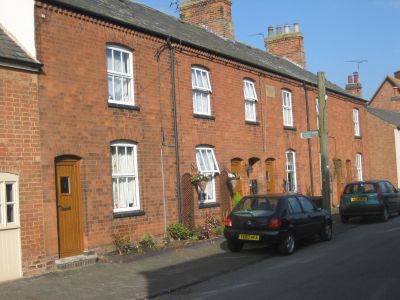
Church Street, Churchover
Churchover is a pretty village on the border of Warwickshire and Leicestershire, four miles north of Rugby. Its history has been documented by Dr C.G. Down in a pamphlet "A Brief History of Churchover", and in the book "A Century in Churchover" complied by Mary Short and Doreen Bradbury of the Churchover Social History Group (2001) upon which I have heavily relied in this summary.
The village is bounded by the River Swift and the Roman road Watling Street. The M6 motorway built in the late 1960s cut the old parish in half but the village remains very much unspoilt and unchanged from Victorian times, with an attractive village green. The village is set in open arable and pasture land.
The village has about a hundred houses, mostly built in red brick. A monastic grange may have existed on or near the site of the local manor house, Coton House. Churchover was predominantly a farming village which used to have five working farms. Many of the villagers worked at Coton House. Later in the nineteenth century when Rugby became a major engineering and railway town, many villagers worked there.
Holy Trinity Church
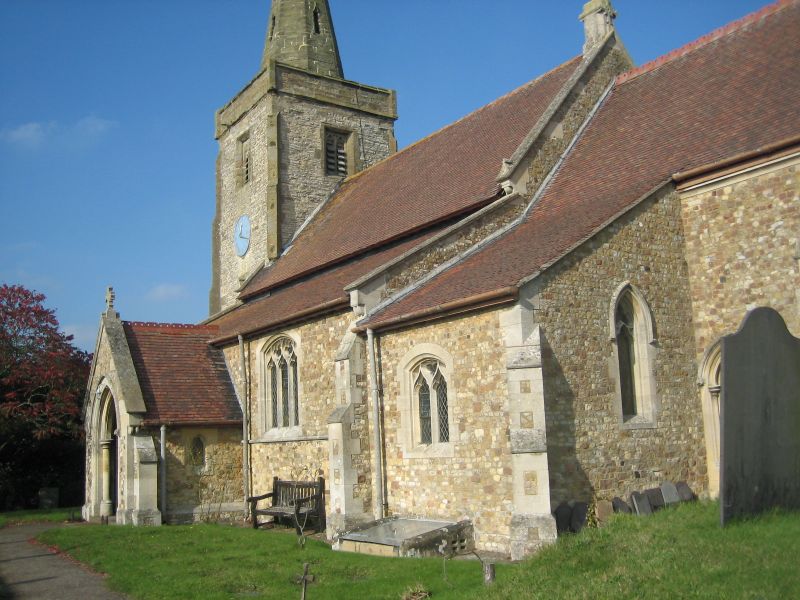
Churchover's parish church is medieval in origin, the tower dating from the 11th century. One of the bells was made in the 15th century. The font is Norman. The church has monuments to its two most prominent local families : the Dixwells and the Grimes. A triangular village green known as a 'Godcake' has a large and attractive spreading chestnut tree.
Many of the older cottages in Churchover have not survived, and were replaced by modern buildings. The old ninetheenth century Rectory was knocked down in the early 1960s. The Rectory's main claim to fame is that the family of Sir Frank Whittle, who invented the jet engine, used to live there.
Leatherland's Barn
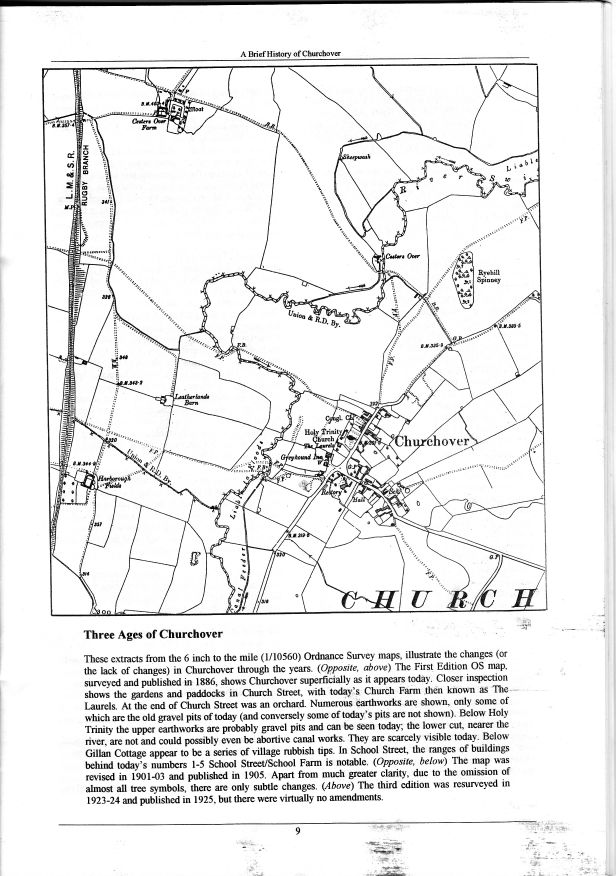
The Ordnance Survey maps show a building in the fields behind Churchover called Leatherlands Barn. Clearly this has some sort of family connection, although Samuel Leatherland was the only direct ancestor who lived in the village and he was a farm labourer. It seems odd that a barn would be named after a farm labourer ! But in his later life he worked as a county council road maintenance worker, and my uncle's theory was that he may have stored his road maintenance tools in the barn which seems plausible. Dr Down told me that the building was more of a farm than a barn, although a close-up on Google maps suggests that it is now derelict.
Leatherland's Barn is mentioned in the book "A Century in Churchover". Lifelong Churchover resident, Dennis Lucas (born in 1925) recalled that, when he was a schoolboy, Leatherland's Barn was used as a shepherd's cottage by Jack Groom, who did odd jobs for farmers. Jack Groom later moved out of the barn to live in a shed at Black Spinney where one day he was found dead. Dennis Lucas recalled that his body was taken away in a Rolls Royce. The village gossip was that he was from a well-to-do family who rejected him because of his hare lip !
Will Leatherland's Churchover Recollections
Will Leatherland was my great uncle. The compilers of A Century in Churchover asked him to document his memories of Churchover because he stayed with his grandparents in the village for six months as a boy following the death of his mother. He continued to visit the village in his later years and became friendly with the lady who lived on the site of the cottage in which his grandparents used to live.
Coton House
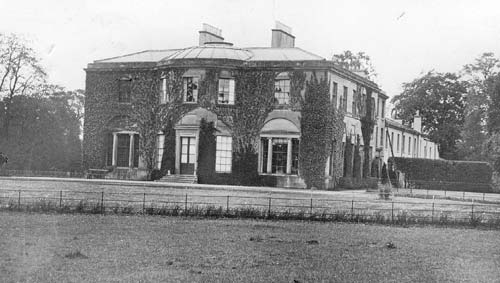
Coton House (1920s)
Coton House was the local manor house about half a mile from Churchover village. The house and manor were owned by the Dixwell family for several generations from the 1550s. In the late eighteenth century Abraham Grimes became the owner. He demolished the Tudor house and built the house which stands today.
In 1874 Coton House was sold to Francis Arkwright (a descendant of spinning machine inventor Richard Arkwright). Francis Arkwright let the house and land to Arthur James and his wife, who was the daughter of a prominent Conservative politician and who became godmother to Elizabeth Bowes-Lyons (the late Queen Mother). After her husband's death she purchased and ran the Coton House estate.
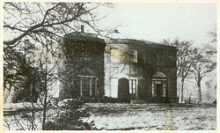
Coton House
My late grandfather told me that his grandmother, Susanna Leatherland, used to work in Coton House as a servant.
During WW2 Coton House was used by airmen. In 1948, following Mrs James' death, it was sold to engineering company BTH who used it as a hostel for apprentices. In 1970 it was bought by the Post Office and used as a management training college.
In 2010 fire broke out at Coton House which caused some damage. Two years later the House was sold to a property developer who planned to redevelop the house into private residences with a housing estate in the grounds. But I understand that it now remains a private residence.
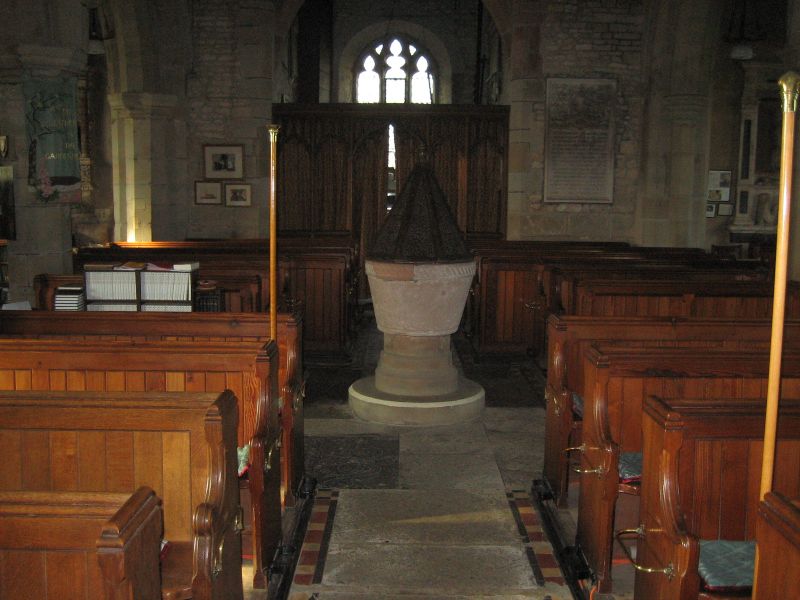
Interior of Holy Trinity Church
SAMUEL AND SUSANNA'S THIRTEEN CHILDREN
.
Samuel and Susannah Leatherland had thirteen children. They were all born and brought up in Churchover. Why did they have so many children ? One reason is probably that Susannah was barely 17 when she married Samuel. Women who married at a young age had longer potential child bearing span, indeed she continued to bear children until she was 41.
So what do we know about Susannah ? Well she was born in Churchover in 1849, daughter of John and Sarah Foster. John Foster was a Churchover man whose first wife, Kitty, died of liver disease at the age of just 32. Four years later John married Sarah Ward, a carpenter's daughter. Susannah was the first child of his second marriage.
The evidence suggests that Susannah lived in Churchover for most of her life. She was born and baptised there, she appears in every Churchover census from 1851 to 1911, and she died there in 1927. She came from quite a large family - she had four half-brothers and one half-sister from her father's first marriage as well as her own brother and sister. Sarah lived in Church Street, Churchover as a girl perhaps in one of the houses pictured below.
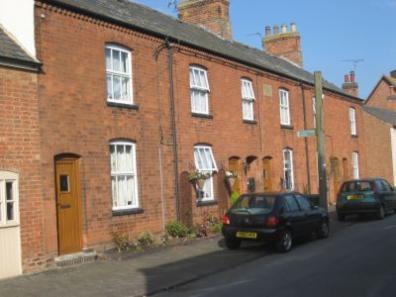
Church St, Churchover
According to the censuses and his children's birth certificates, Susannah's father was a labourer. There is a family story that he was connected with canal boats in some way, or that he was a miller, although I have found no evidence to support this.
Susannah's marriage certificate says she was a servant. My grandfather told me that she worked in Coton House, the large manor house on the edge of Churchover.

The Children
Samuel and Susanna's first child, GEORGE, was born three days before their marriage. It was quite common for parents to marry when the wife was already pregnant. This does not imply a "shotgun wedding", it was simply the custom at the time. Nevertheless it is slightly unusual to see a marriage so soon after the birth of the first child. I wonder whether the baby was born prematurely, particularly as he died when he was only a month old.
Susannah and Samuel had two more children : WILLIAM in 1867 and JOHN EDWARD (my great grandfather) in 1870.
Most of the children left home in their teens. This is understandable bearing in mind that there were twelve surviving children and, as far as we know, Samuel was only a farm labourer in his early years. I don't know exactly where in Churchover they lived, my great uncle told me that the original cottage where they lived was demolished. But a farm labourer at that time would have probably lived in a small rented cottage, so it would have been crowded.
By 1891 when he was 23 years old, WILLIAM had left Churchover and moved south. He was living in Harrow High Street, Middlesex working as a footman and domestic servant with 14 other servants in a large house. In April 1896 at the age of 28 he married Emily Flick in Hendon. She was the daughter of George Alfred Flick, a railway signalman, who lived in Bethnal Green.
William became a pub landlord. In 1901 he was working as a "beer retailer" at The Cricketers pub in Watford. By 1911 he was running the Greyhound pub in Wembley.
William and Emily had a son and daughter, George and Hilda. The family moved to Essex. William died in Southend on Sea at the age of 50.
George married Nellie Harwood in Prittlewell, Essex in 1922. They had three children : Peter, Miriam and Joan. The family emigrated to Canada in the 1950s.
JOHN EDWARD worked on a farm for a while after leaving school but became dissatisfied with this and decided to join the army. He joined the 2nd Battalion of the Royal Warwickshire Regiment in 1886 at the age of 16 and served in India and Ceylon (Sri Lanka) in the late 1880s and early 1890s. He became a drummer boy and a bandmaster. He was discharged in 1898.
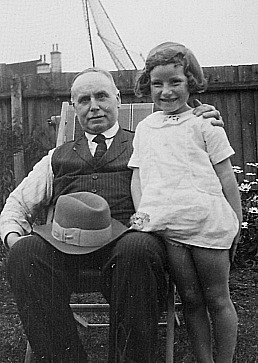
John Edward (Jack) Leatherland with granddaughter Irene (my mother)
In July 1897 he married Elizabeth Abbis in Birmingham. He was living in Gem Street, Birmingham. Elizabeth was the daughter of Walter Charles Abbis, the village blacksmith in Harlington, Bedfordshire. She was working as a domestic servant in Fulham in 1891.
After his discharge from the army, he worked at Gem Street Industrial School, Birmingham, and later as a valet and then for Cadburys. Following the death of his wife, he advertised for a housekeeper to help look after his four young boys. Rosina Atkins, a Londoner, answered the ad. Later they married and had a daughter Rosa.
Rosa was very artistic and used to work for Cadburys designing chocolate boxes. She married Roy Dunnett and they had two daughters, Valerie and Sylvia.
SAMUEL was born in 1872. He also left home at an early age to move south. In 1891 he was 19 years old and living at Peterborough Road, Harrow. He worked as a footman domestic servant in the family of Flora Bosworth Smith (wife of Reginald Bosworth Smith, a schoolmaster at Harrow School and an author). It's interesting to note that two brothers, Samuel and William, were both working as servants in Harrow.
Wedding of Samuel Leatherland to Ada Phillips in Churchover 1905
In his youth Samuel travelled to the Klondyke in Canada to join in the gold rush. In 1905 he married Ada Philips in Great Amwell, Hertfordshire. Ada was the daughter of a telegrapher, who later worked as a Post Office engineer. In 1906 they had a son, Cyril, and in 1911 a daughter, Mabel. Samuel ran a wholesale and retail confectionary and tobacco business with his brother Alfred at Amwell End in Ware.
Sam and Alf with the Leatherland Brothers horse and cart
Following his father's death in 1953, Cyril ran the family tobacconists and sweetshop called "Leatherlands" in Amwell End. Cyril’s retirement in 1982 was reported in the local newspaper the Hertfordshire Mercury :
“ A Ware family business, which was started at the beginning of the century, closes at the end of the month. Cyril Leatherland, who runs the tobacconist and confectionery shop at Amwell End, has decided at the age of 76 to retire. The reason for the decision is partly because of health, but business was also proving more and more difficult. "It’s sad to leave," he said, "but the shop would not have been able to carry on for long. Trade here has been gradually decreasing since VAT was increased last year. It made a lot of people give up smoking." The shop was opened by his uncles, Alfred and Harry Leatherland, in 1900.”
Cyril died unmarried in 1992. I recently made contact with Samuel's grandaughter Patricia Evans who told me that Samuel's daughter, Mabel, married Charles Ballands who devoted his life to the cinema and became the owner of the independent Astoria Cinema in Ware. Charles Ballands started working at the cinema in 1929 as a re-wind boy at the age of 14. He gradually worked his way up the ranks until he became the manager and owner. In the late 1950s cinema became less popular so Mr Ballands tried to boost audiences with live musical interludes, including a very early appearance by Cliff Richard. 
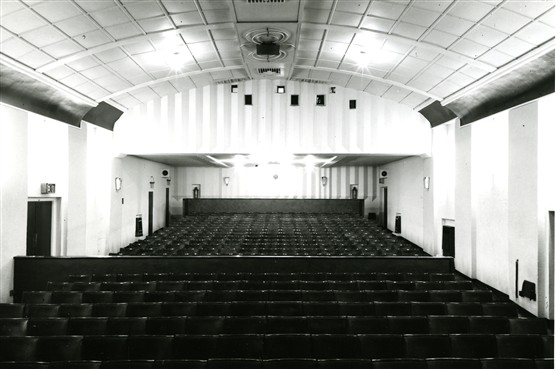
Interior of the Astoria Cinema, Ware
In the end, part-time bingo was the solution in the 60s and 70s. After Charles Ballands died in 1975, his family continued to operate the Astoria which was one of the last independently owned cinemas in the country. Sadly, it closed for good in 1979 but continued to be used as a place of entertainment as a nightclub.
HANNAH ELIZABETH (known as Lizzie) was born in 1874. In the 1891 census she was a 16 year old general servant with a farmer, John Moxon, in Harborough Magna, Leicestershire. In 1901 she was living and working at Perrets Brook House, Cirencester, Glos as a parlour maid. My grandfather told me that his Aunt Lizzie helped to look after him and his three young brothers following the death of their mother.
Lizzie had a son, Frank, in 1907 six years before she married Jim Baker, a joiner and carpenter, in 1913. Jim married Lizzie Leatherland after the death of his first wife.
Frank Leatherland lived in Birmingham. In 1953 he married Florence Maud at the Boatman's Hall, although he was a wages and costs clerk in a joinery firm, rather than a boatman.
JOSHUA CHARLES (known as Charles) was born in 1877. Like most of his siblings he left home at an early age. In the 1891 census aged just 14 he was a farm servant in Shawell, Leiecestershire. Ten years later he was a footman in Glasgow. He served in the Royal Army Medical Corps in WW1 and married Jemima Gibb in Paisley in 1920. They had one child, Ronald born in 1923.

Hafton Castle
Charles became butler to a wealthy family, the Allen family, in Dunoon, Argyll, The Allens owned a big estate on the side of Holy Loch at Hafton, Hunters Quay. Hafton is in fact a large castle, which a few years ago was for sale for £1.6 million !
Charles died in 1963 in Paisley at the age of 86. His widow Jemima died in 1977.
I once made contact with a relative of Jemima Gibb who lives in Canada and also with Charles Leatherland's grandaughter, Moira.
Silas Henry (known as Harry)was born in 1878. By 1901 he had moved to London like many of his brothers and was working as a bakers’ assistant with the Trowles family in York Street, Marylebone. In 1905 he married Annie Davey in 1905 in Clapton. They had six children : Ethel Annie, Ivy May, Elsie, Hilda, Arthur, and Francis Ronald. Two of them settled in the Isle of Wight.
In 1910 Harry was living at the John Barleycorn pub, Thresher’s Bush, Harlow, Essex (Kelly’s Directory). By 1912 he had moved to Chertsey in Surrey where he owned a sweetshop and confectionary business. He died in 1951.
ALFRED was born in 1880. By the 1901 census he was living in Scotland working as a domestic footman in Fettes College in Edinburgh (Tony Blair’s old school) along with his brother Walter. He joined his brother Harry (Silas Henry) in running his retail and wholesale confectionary business in Ware. Alf married May Warby in 1909 in Ware. He died in 1952 in Weybridge.
SARAH EMILY (known as Emmie) was born in 1882. In 1908 she married Ernest Grimmett in Churchover. He was a 32 year old platelayer (railway maintenance worker) on the Great Central Railway and lived in Wembley. The Great Central Railway ran from London Marylebone via Rugby Central and then to Nottingham and Chesterfield. Their marriage certificate describes her as a domestic servant. Emily died in 1958 in Croxley Green, Herts.
FREDERICK was born in 1883. The Admission Register of Churchover School (held in Warwick Record Office) shows that he went to the local school at the age of 4 and left in 1895 at the age of 12. In 1901 he was an 18 year old domestic gardener living with his parents in Churchover.
Frederick married Sarah Mabel Jessop in 1908 in Keresley, Coventry. They had several children : Arthur Ernest (1909). Frederick (1911) who died as a baby, William (1912), Florence (1919 who died in infancy) Beatrice and Phyllis (twins 1922). He ater worked at Daimler Motors. He died in 1950 in Coventry..
WALTER ERNEST was born 1885. The Churchover School Admission Register shows that he began school at the age of 4 and left before his 13th birthday. In 1901 he was 15 and working in Scotland as a domestic page in Fettes College where his brother Alfred also worked. Sadly, Walter died in 1906 at the age of 21 of acute phthisis (TB) and asthma. He is buried in the churchyard in Churchover with his parents.
ARTHUR JAMES was born in 1887. He was admitted to Churchover School even earlier than his brothers at the age of 3. He married Amy Lowe in Ware, Herts in 1911, and lived in the Harlow and Ware area working as a wholesale confectioner (almost certainly with his brothers, Alf and Sam, who set up their business in the area).
Arthur was killed in a cycling accident at the age of 37 in Harlow in 1923. He is buried in the churchyard at Churchover. According to my great uncle he had a tallyman business in the Ware area and was cycling around collecting his money when he had his accident. In July 1923, the Rugby Advertiser reported that :
"On Wednesday a sad gloom was cast over the village by the news of the tragic death of Mr A Leatherland, who met with a cycle accident and received injuries which proved fatal. The body was conveyed from Essex, where the accident took place, and laid to rest in the churchyard on Saturday".

Gravestone of Samuel Leatherland and his son Walter Ernest in Churchover churchyard
EDITH ALICE was Samuel and Susanna's last child born in 1890. My grandfather told me that she worked as a maid in a vicarage (possibly the vicarage in Churchover) and that she looked after her mother, Susanna, in her old age. This is confirmed by the 1911 census which shows Susanna, now a 61 year old widow, living with Edith. In 1920 she married Jess Gould in Rugby. He was a welder / metalworker at the BTH Works at Rugby, later part of GEC. Edith seems to have been the only member of the family to remain living in Churchover. Edith and Jess settled in Rugby. She died in 1949.
Churchover School Admission Registers
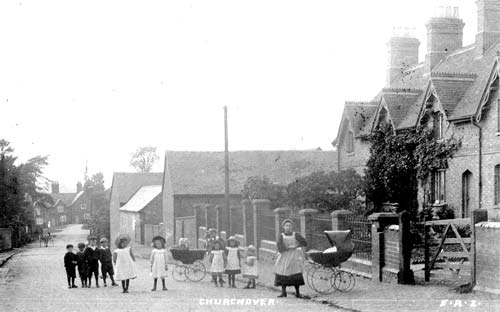
Churchover in the 1900s
I looked at the admission registers for Churchover Infants and Junior School which can be found in Warwick County Record Office. The registers begin in 1886 and list all pupils admitted to the school. Here is a summary :
| Name | Admission Date | Parent/Guardian | DOB | Date left / notes |
| Fred Leatherland | April 1887 | Samuel, Churchover | 22 Apr 1883 | 22 Apr 1885 |
| Walter Leatherland | May 1889 | Samuel, Churchover | 4th Jul 1885 | 31 Mar 1898 |
| Arthur Leatherland | April 1890 | Samuel, Churchover | 11th Mar 1887 | (No date) |
| Willie Leatherland | 11 Jan 1909 | Samuel (grandfather) Churchover | 22nd May 1902 | (No date) |
| Leslie Leatherland | 25 Sep 1922 | Mrs Leatherland (grandmother) Churchover | 2nd Nov 1915 | 9 Oct 1922 'here on a visit' |
| Edith Leatherland | Sept 1894 | Samuel (roadman) | 4th Jul 1890 | (No date) |
| Charles Leatherland | 7 Apr 1902 | John, Churchover | 18th Apr 1898 | (No date) |
| Arthur Grimmett | 16 Jul 1917 | [Illegible] | 18th Oct 1909 | 2 Feb 1919 (previous school Park Lane, Wembley |
| Eric Walter Grimmett | 16 Jul 1916 | [Illegible] | 2nd Oct 1912 | 2 Feb 1919 |
| Elsie Grimmett | 7 Sep 1925 | Ernest Grimmett, 7 Wembley Hill, Wembley | 20th Mar 1917 | 20 Oct 1925 (previous school Park Lane, Wembley) |
Notes on Churchover School Admission Registers :
Fred was a younger brother of John Edward Leatherland, he later settled in Coventry
Walter was another brother, he later died at the age of 21 in Churchover
Arthur settled in Ware, and died in a cycling accident in 1923
Willie is my great Uncle Will of Paignton, he went to Churchover to stay with his grandparents after the death of his mother.
Leslie was Arthur's son. He later became a farmer in Yorkshire.
Edith was the youngest child of Samuel and Susannah, she married Jess Gould and settled in Rugby.
Charles is my grandfather. His family were living in Birmingham so I am not sure where he attended school in Churchover at the age of 4.
Arthur, Eric and Elsie Grimmett were all children of Sarah Emily Leatherland (daughter of Samuel and Susanna) who married Ernest Grimmett in Churchover in 1908, and later moved to Willesden. Arthur later married a cousin, Hilda Leatherland and lived in the Isle of Wight.